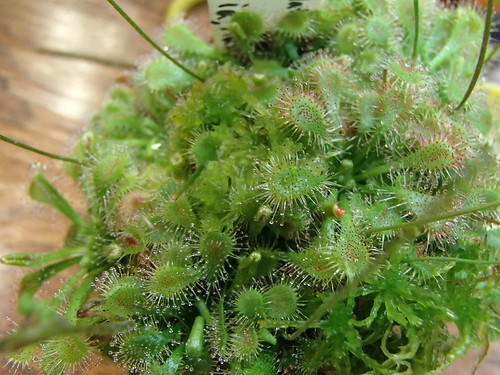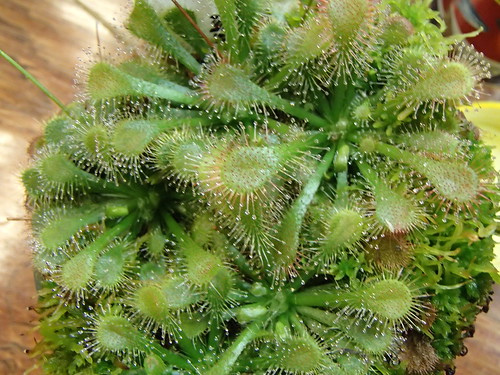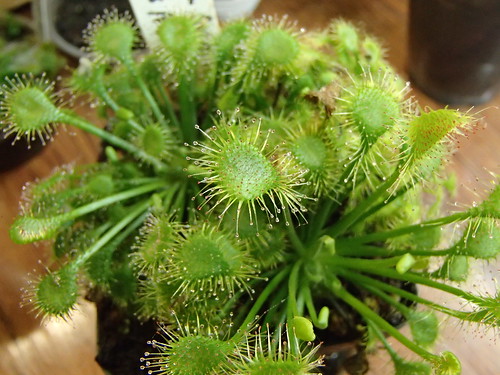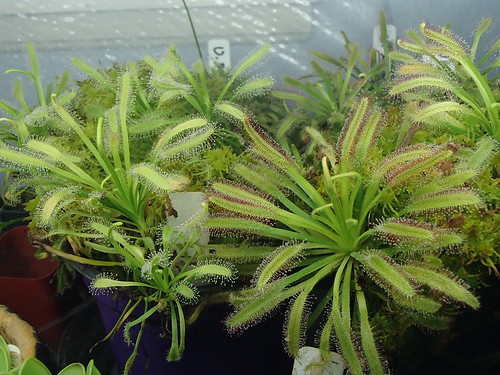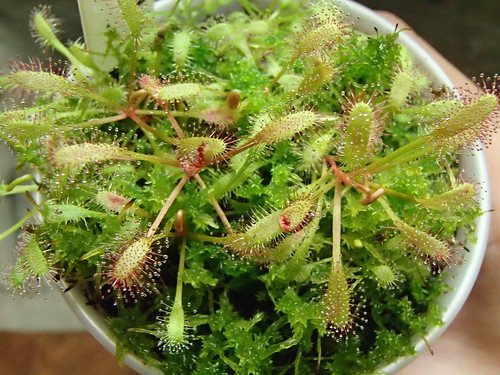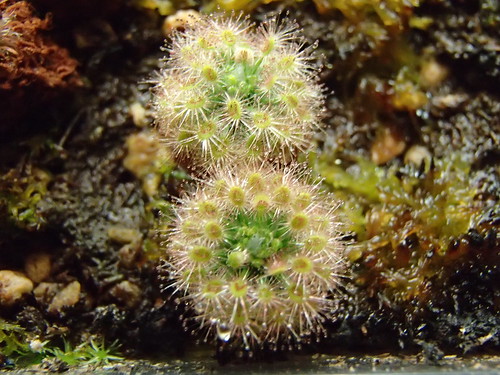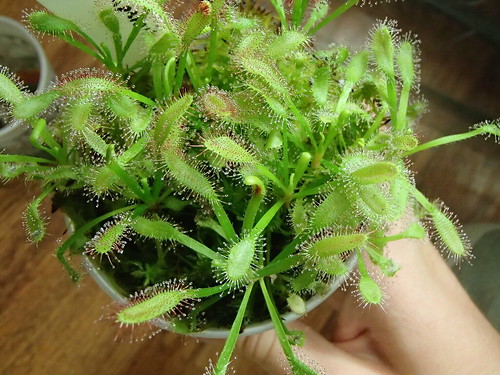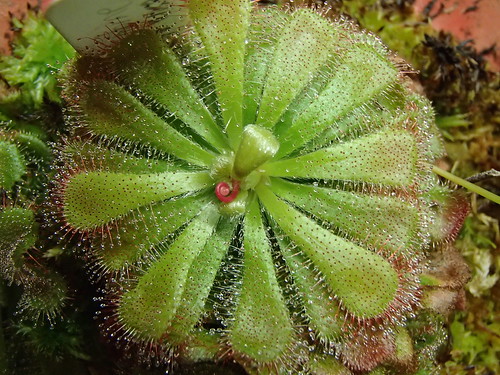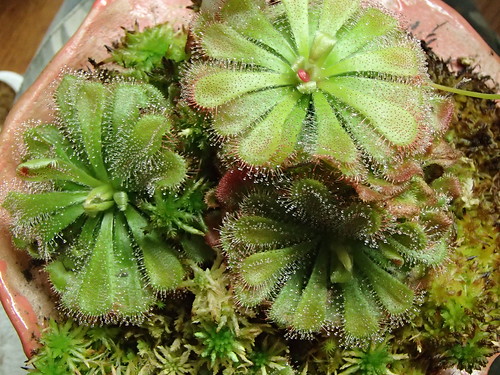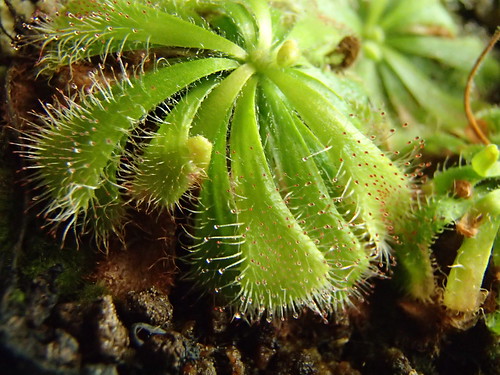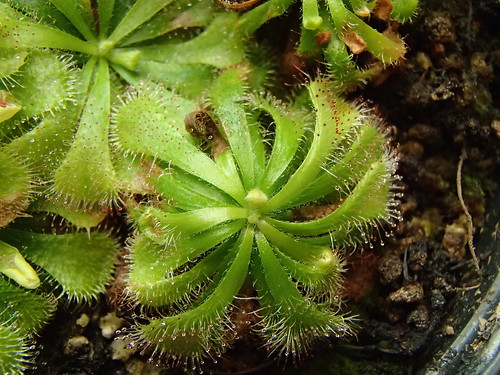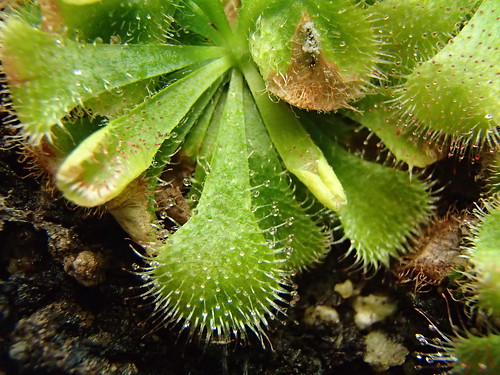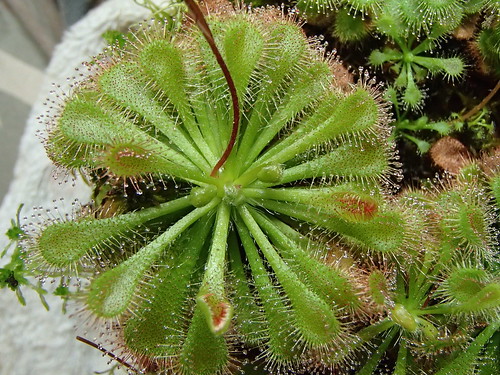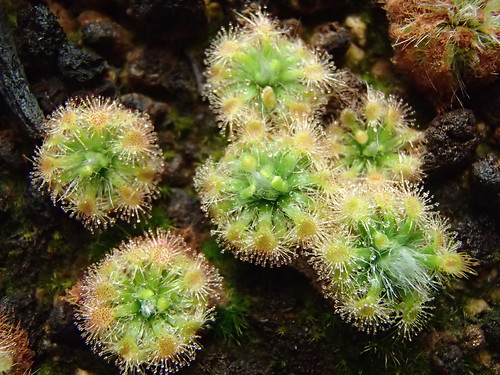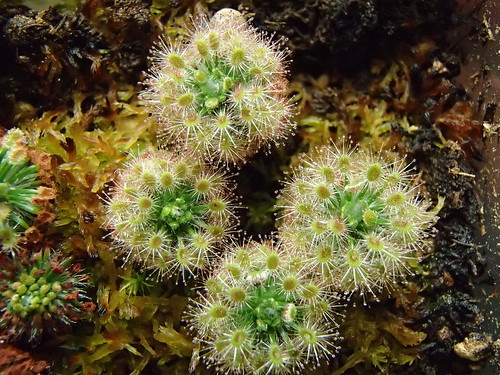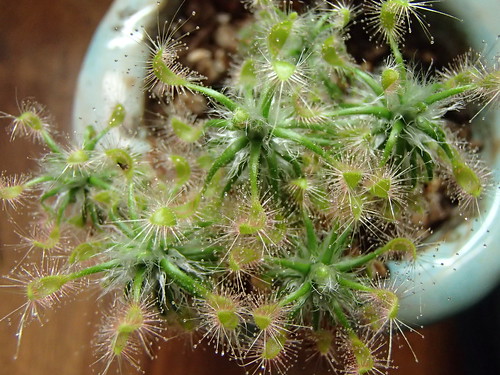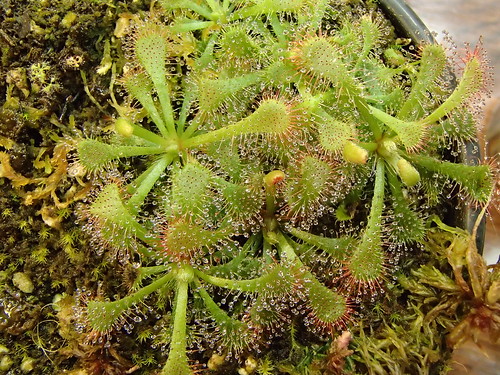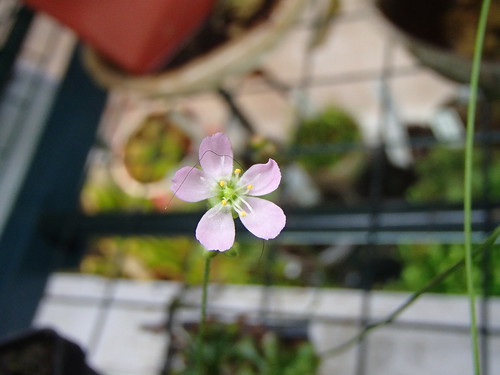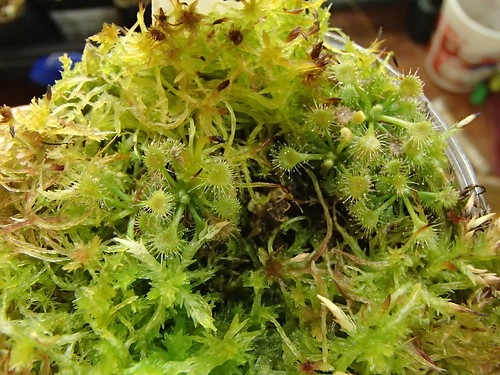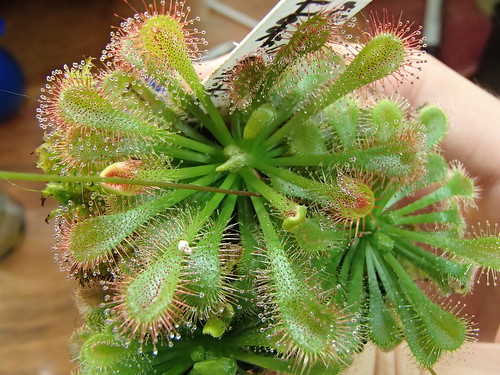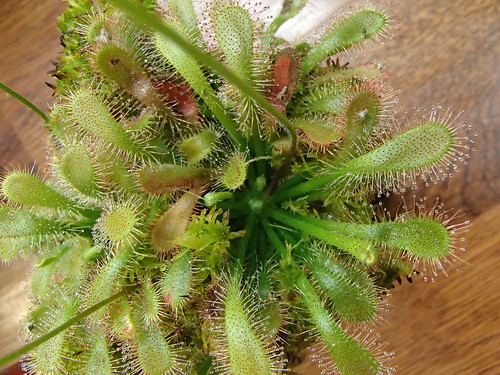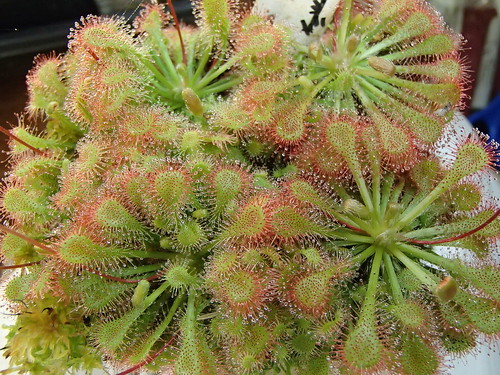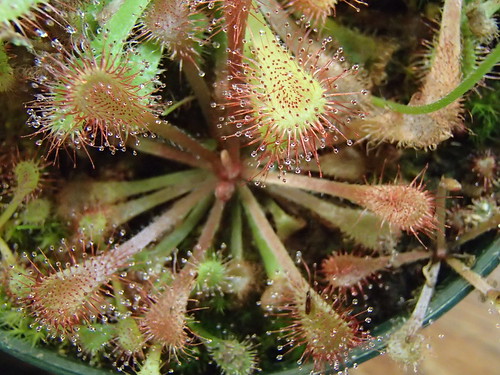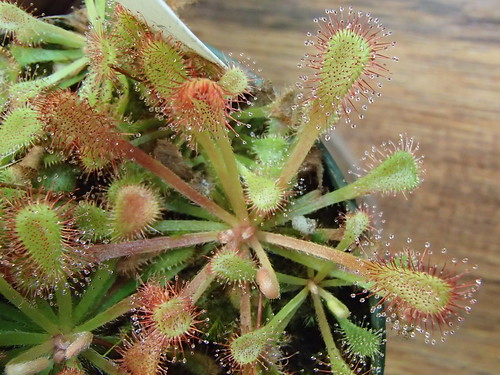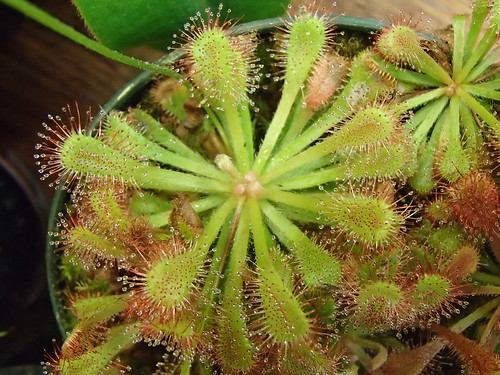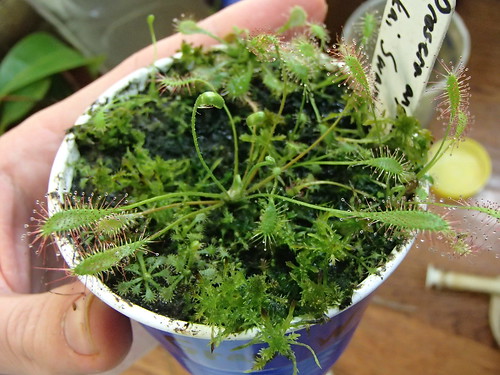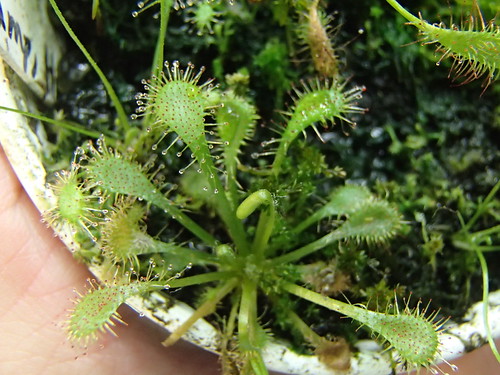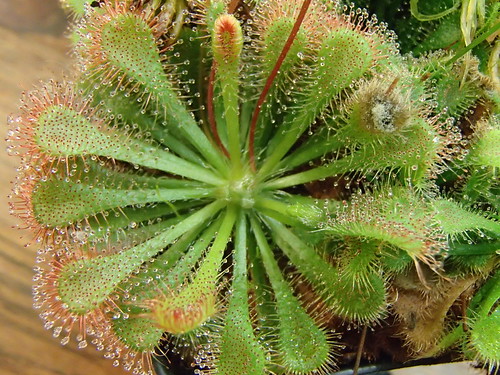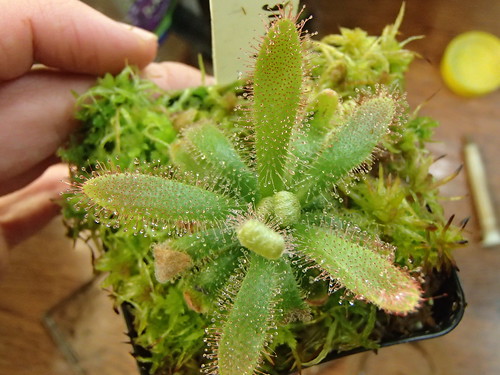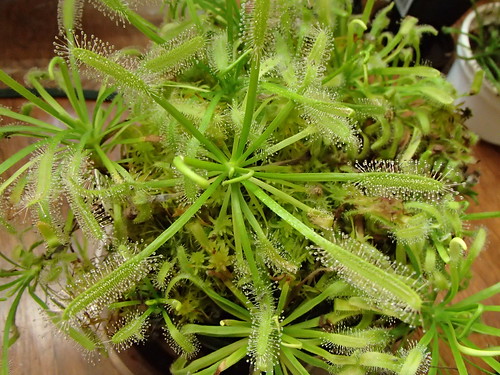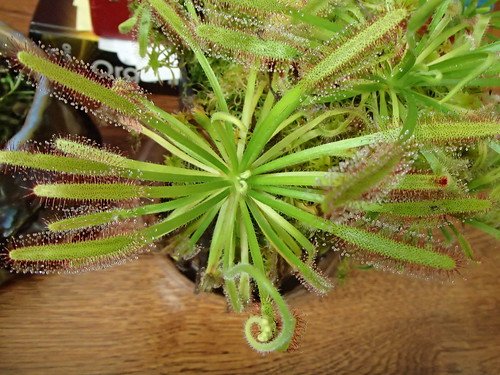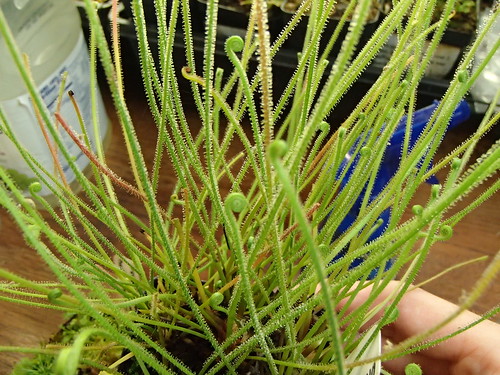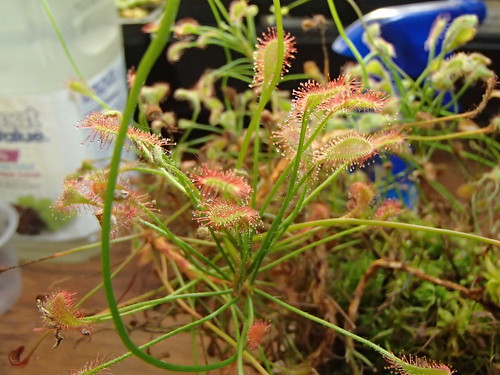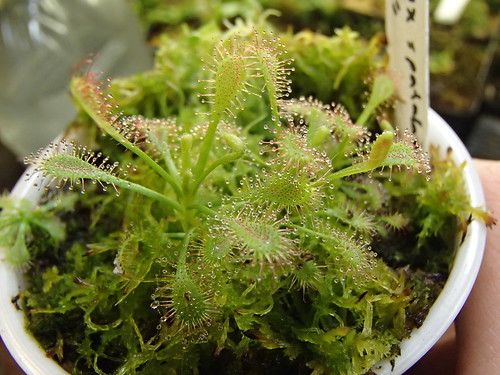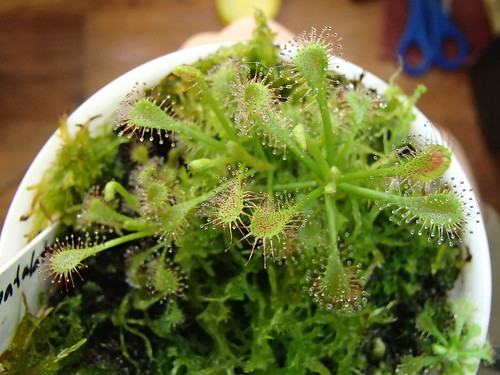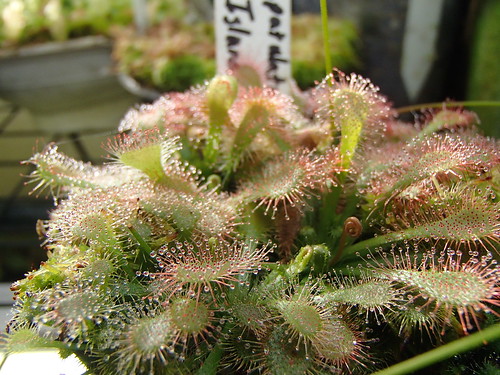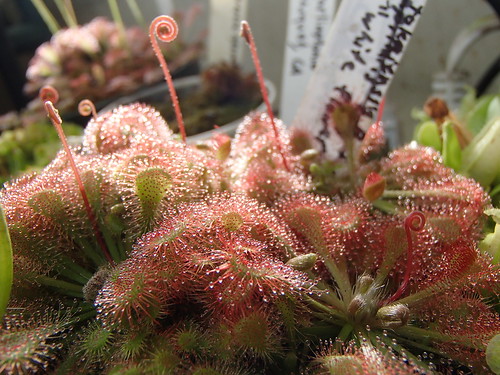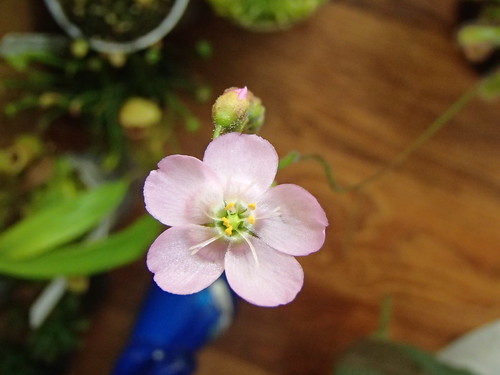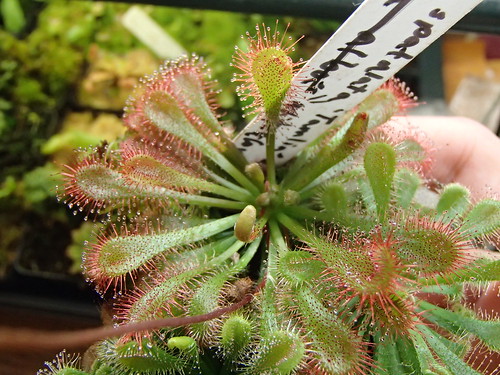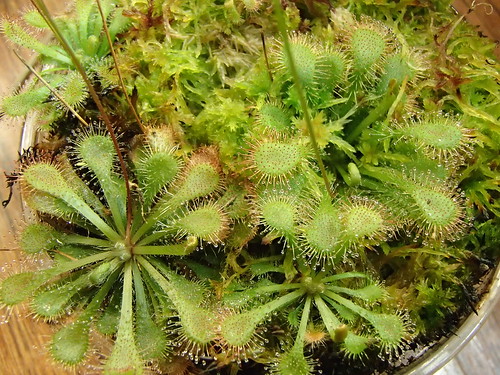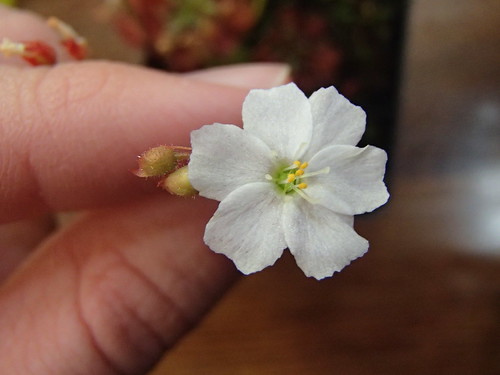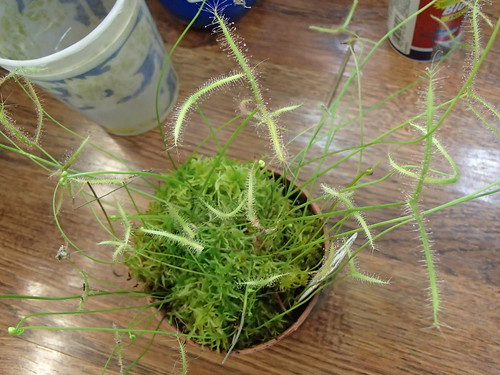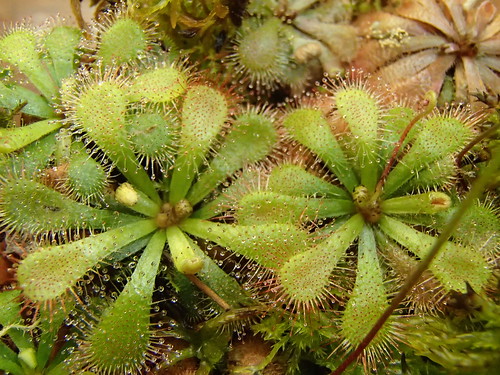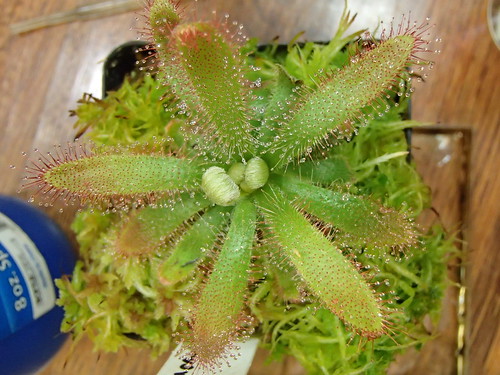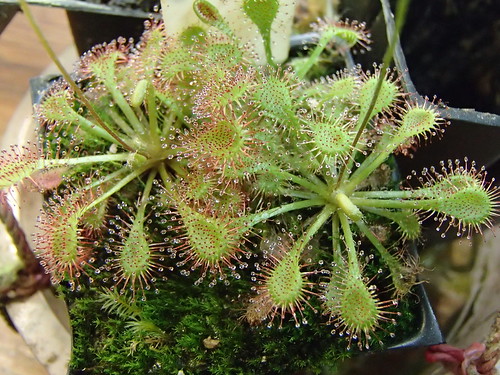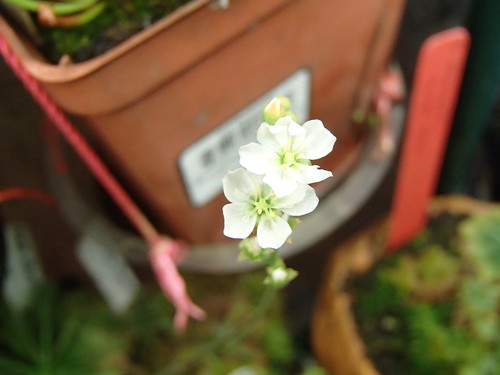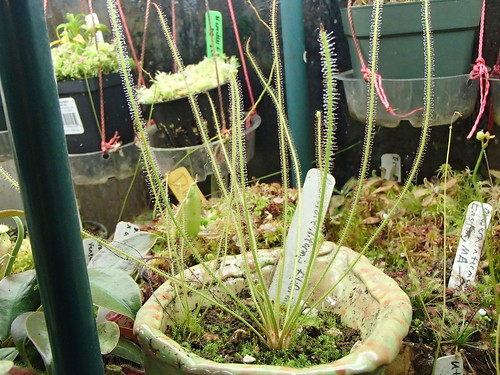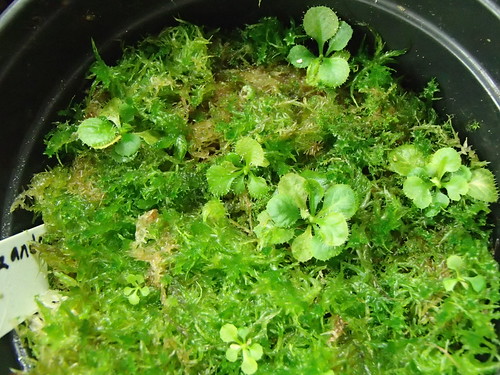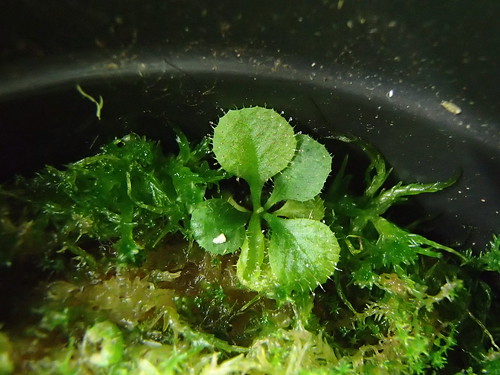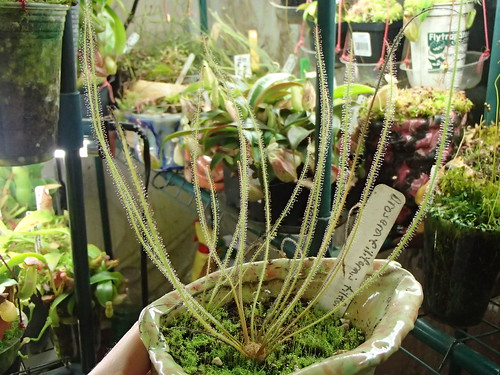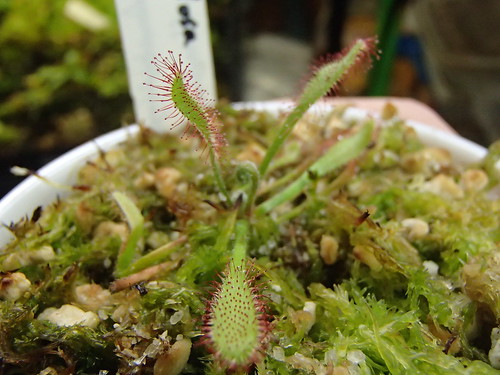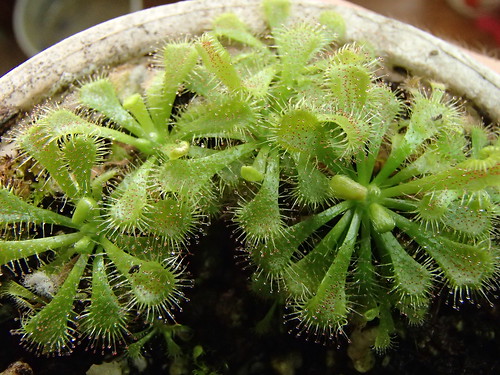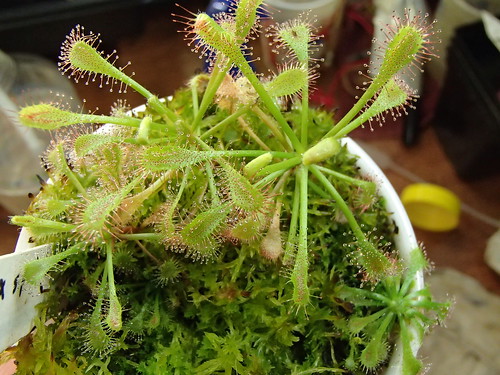Post by Not a Number on Aug 19, 2014 16:03:42 GMT
D. admirabilis and D. cuneifolia are so similar that some taxonomists consider them the same species so I find it odd you would rule on D. cuneifolia but consider D. admirabilis.
The leaf shape is wrong, the distribution and density of tentacles is wrong, the shape of the unopened leaves is wrong.
Other details I can't see from the pictures - stipules, structures on the undersides of leaves, if there is a stem, how persistent are old leaves, "skirt" formation of dead leaves etc.
Here is Debbert's type drawings from his original publication of D. admirabilis
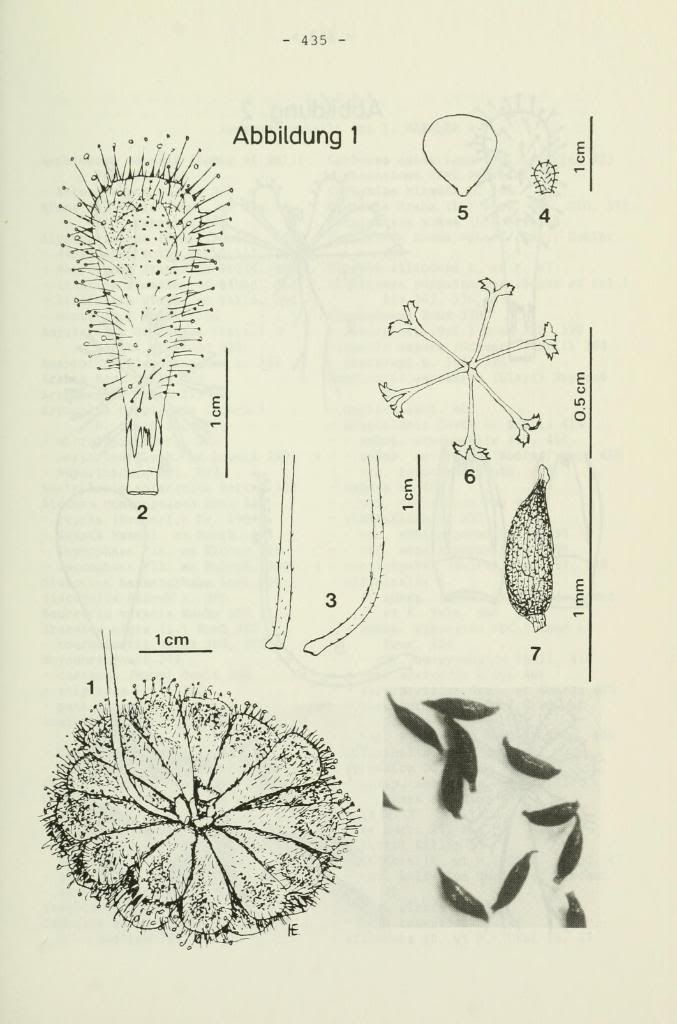
Here is his description in Latin German and a translation from German via Google Translate (Latin translates poorly on Google):
Latin:
Drosera admirabilis P. Debbert, spec. nova
Holotypus: Palmietriver, Cape Province, kultiviert im
Botanischen Garten München, 25.6.1985,
P. Debbert Nr. 15 (M; Iso: BOL)
Planta perennis rosulata. Folia rosularia omnia humo
dense appressa, cuneiformia, apice obtusa rotundata, 1,6- 2
cm longa, 5-6 mm lata. Stipites tentaculorum partis mediae
folii apicem versus leviter rubelli, basin vitrei, albidi ,
teretes; globuli tentaculorum atrorubri ad nigricantes.
Pagina inferior foliorum pilis albidis ca. 0,8-1 mm longis
obsita parte basali glabra vel subglabra excepta. Stipulae
pergamaceae hyalinae basi connatae in lobos 3 cuneiformes
partitae; lobi laterales lobo mediane distincte angustiores
et longiores; lobus medianus apice iterum in lobos 2-4
brevissimos partitus. Scapus erectus basi non vel leviter
tantum curvatus , 13-21 cm longus, basi rubellus sparsim
albidi-pilosus , in parte superiore viridis tentaculis
crebris brevistipitatis obsitus. Racemus 2-7 (-15)-florus
floribus 0,8-1,3 cm distantibus. Sepala 5, obovata, apice
obtusa rotundata, leviter rubella, 3-3,5 mm longa, 1,5-2 mm
lata, subtus tentaculis crebris brevistipitatis obsita.
Petala 5, rosacea vel subviolacea, obovata, apice obtusa
rotundata, integra, ca. 8 mm longa, 6-8 mm lata. Stamina 5,
ca. 2 , 5 mm longa. Ovarium laete viride. Styli 3, in ramos
duos partiti, 2 , 5 mm longi parte connata 1 mm longa, basin
versus albidi, apicem versus pallide rosei. Stigmata plana,
subcuneif ormia, rosacea, 0,5-1 mm longa, apice 0,5-1 mm
lata, cuneatim fimbriata. Semina nigricantia, anguste
ellipsoidea, basi breviter angustata, apice breviter acuminata,
superficie foveolata. Floret aestate.
German:
Ausdauernde, krautige Rosettenpflanze. Wurzeln zu 2 bis
4, 6-9 cm lang, gleichmäßig 0,5-1,5 mm dick, im unteren
Bereich zuweilen verzweigt. Rosettenblätter alle dicht dem
Boden anliegend, keilförmig, vorne stumpf abgerundet, 1,6-2
cm lang und 0,5-0,6 cm breit, Tentakelstiele am oberen
Blattrand rötlich, flach, keilförmig spitz auslaufend;
Tentakelköpfchen länglich gestreckt, keine Tröpfchen bildend.
Tentakelstiele auf der Blattmitte im oberen Teil
leicht rötlich, im unteren Bereich glasig, weiß, rund,
deutlich kürzer als die Randtentakeln; Tentakelköpfchen
dunkelrot bis schwärzlich. Blattunterseite mit weißlichen,
etwa 0,8-1 mm langen Haaren besetzt, im unteren Fünftel
kahl oder nur mit vereinzelten Haaren. Nebenblätter pergamentartig,
durchscheinend, am Grunde verwachsen, in drei
keilförmige Zipfel geteilt, die beiden Randzipfel deutlich
schmäler und länger als der Mittelzipfel, Mittelzipfel am
Ende wiederum mit zwei bis vier sehr kurzen Zipfeln versehen.
Blütenschaft aufrecht, an der Basis nicht oder nur
sehr schwach gekrümmt, 13-21 cm lang, am Grunde rötlich und
spärlich weißhaarig, im oberen Teil grün und mit zahlreichen
kurzgestielten Tentakeln besetzt. Blütentraube mit 2-7
(-15) Blüten; Blütenabstand 0,8-1,3 cm. Kelchblätter zu 5,
verkehrteiförmig, vorne stumpf gerundet, leicht rötlich,
3-3,5 mm lang und 1,5-2 mm breit, auf der Unterseite mit
zahlreichen kurzgestielten Tentakeln bedeckt. Kronblätter
zu 5, rosa oder schwach violett, verkehrteiförmig, vorne
stumpf gerundet, glattrandig, ca. 8 mm lang und 6-8 mm
breit. Staubblätter zu 5 , ca. 2,5 mm lang, mit weißem
Stiel; Pollen hellgelb. Fruchtknoten hellgrün. Griffel zu
3, in je zwei Äste gespalten, 2 , 5 mm lang, am Grunde kurze
(1 mm) verwachsen, im unteren Teil weißlich, im oberen Teil
blaßrosa. Narben flächig, fast keilförmig, rosa, 0,5-1 mm
lang, am Ende 0,5-1 mm breit, keilförmig ausgefranst. Samen
schwärzlich, schmal ellipsoidisch, an der Ansatzstelle kurz
verschmälert, vorne kurz zugespitzt, die Oberfläche mit
kleinen Vertiefungen versehen.
Blütezeit: In Mitteleuropa Juni bis Ende Juli, in der
Heimat ebenfalls im Sommer.
Vorkommen: In den Bergen vom Palmietriver, auf quelligen,
moorigen Flächen, nicht selten in Moospolstern.
Chromosomenzahl: 2n = 40
Translation from German:
A perennial herbaceous rosette plant. Roots up to 2
4, 6-9 cm long, 0.5-1.5 mm thick, evenly, in the lower
Area sometimes branched. Rosette leaves lying close to the ground,
wedge-shaped, front bluntly rounded, 1.6 to 2
cm long and from 0.5 to 0.6 cm wide, tentacle stalks at the top
Leaf margin reddish, flat, wedge-shaped tapering to a point;
Tentacles stretched elongated head, not forming droplets.
Tentacle stalks on the leaf in the upper middle part round,
slightly reddish, translucent white at the base,
significantly shorter than the marginal tentacles, tentacle heads
dark red to blackish. Underside of leaves with whitish,
0.8-1 mm long hairs, in the bottom fifth
glabrous or with scattered hairs. Stipules parchment-like,
translucent at the base, in three
wedge-shaped lobes divided, the two marginal lobes significantly
narrower and longer than the middle lobe, middle lobe on
End again provided with two to four very short lobes.
Scape erect, or very slightly curved at the base, 13-21 cm long,
reddish at the base and with sparse white hairs, green in the upper
part covered with numerous short-stalked tentacles. Flowers with 2-7
(-15) raceme, blooms equally spaced from 0.8 to 1.3 cm. Sepals about 5,
obovate, front bluntly rounded, slightly reddish,
3-3.5 mm long and 1.5-2 mm wide, the bottom covered with
numerous short-stalked tentacles. Petals
to 5, pink or pale purple, obovate front
bluntly rounded, smooth edges, about 8 mm long and 6-8 mm
wide. Stamens about 5, about 2.5 mm long, with white
Stalk and bright yellow pollen. Ovary light green. Pen to
3 split into two branches, 2, 5 mm long, at base short
(1 mm) grown in the lower part whitish, the upper part
pale pink. Scar area, almost wedge-shaped, pink, 0.5-1 mm
long, 0.5-1 mm wide at the end, frayed wedge-shaped. Seed
blackish, narrowly ellipsoidal, short at the point of attachment
narrowed, tapered front briefly, with the surface
small recesses provided.
Flowering time: In Central Europe June to late July, in the
Home in the summer also.
Occurrence: In the mountains of Palmietriver on awkward,
swampy areas, often in moss.
Chromosome number: 2n = 40
There may be some transcription errors from the OCR conversion of the text. I tried to correct most of these before translation.
You can also find high resolution scans of herbarium specimens online.
The leaf shape is wrong, the distribution and density of tentacles is wrong, the shape of the unopened leaves is wrong.
Other details I can't see from the pictures - stipules, structures on the undersides of leaves, if there is a stem, how persistent are old leaves, "skirt" formation of dead leaves etc.
Here is Debbert's type drawings from his original publication of D. admirabilis

Here is his description in Latin German and a translation from German via Google Translate (Latin translates poorly on Google):
Latin:
Drosera admirabilis P. Debbert, spec. nova
Holotypus: Palmietriver, Cape Province, kultiviert im
Botanischen Garten München, 25.6.1985,
P. Debbert Nr. 15 (M; Iso: BOL)
Planta perennis rosulata. Folia rosularia omnia humo
dense appressa, cuneiformia, apice obtusa rotundata, 1,6- 2
cm longa, 5-6 mm lata. Stipites tentaculorum partis mediae
folii apicem versus leviter rubelli, basin vitrei, albidi ,
teretes; globuli tentaculorum atrorubri ad nigricantes.
Pagina inferior foliorum pilis albidis ca. 0,8-1 mm longis
obsita parte basali glabra vel subglabra excepta. Stipulae
pergamaceae hyalinae basi connatae in lobos 3 cuneiformes
partitae; lobi laterales lobo mediane distincte angustiores
et longiores; lobus medianus apice iterum in lobos 2-4
brevissimos partitus. Scapus erectus basi non vel leviter
tantum curvatus , 13-21 cm longus, basi rubellus sparsim
albidi-pilosus , in parte superiore viridis tentaculis
crebris brevistipitatis obsitus. Racemus 2-7 (-15)-florus
floribus 0,8-1,3 cm distantibus. Sepala 5, obovata, apice
obtusa rotundata, leviter rubella, 3-3,5 mm longa, 1,5-2 mm
lata, subtus tentaculis crebris brevistipitatis obsita.
Petala 5, rosacea vel subviolacea, obovata, apice obtusa
rotundata, integra, ca. 8 mm longa, 6-8 mm lata. Stamina 5,
ca. 2 , 5 mm longa. Ovarium laete viride. Styli 3, in ramos
duos partiti, 2 , 5 mm longi parte connata 1 mm longa, basin
versus albidi, apicem versus pallide rosei. Stigmata plana,
subcuneif ormia, rosacea, 0,5-1 mm longa, apice 0,5-1 mm
lata, cuneatim fimbriata. Semina nigricantia, anguste
ellipsoidea, basi breviter angustata, apice breviter acuminata,
superficie foveolata. Floret aestate.
German:
Ausdauernde, krautige Rosettenpflanze. Wurzeln zu 2 bis
4, 6-9 cm lang, gleichmäßig 0,5-1,5 mm dick, im unteren
Bereich zuweilen verzweigt. Rosettenblätter alle dicht dem
Boden anliegend, keilförmig, vorne stumpf abgerundet, 1,6-2
cm lang und 0,5-0,6 cm breit, Tentakelstiele am oberen
Blattrand rötlich, flach, keilförmig spitz auslaufend;
Tentakelköpfchen länglich gestreckt, keine Tröpfchen bildend.
Tentakelstiele auf der Blattmitte im oberen Teil
leicht rötlich, im unteren Bereich glasig, weiß, rund,
deutlich kürzer als die Randtentakeln; Tentakelköpfchen
dunkelrot bis schwärzlich. Blattunterseite mit weißlichen,
etwa 0,8-1 mm langen Haaren besetzt, im unteren Fünftel
kahl oder nur mit vereinzelten Haaren. Nebenblätter pergamentartig,
durchscheinend, am Grunde verwachsen, in drei
keilförmige Zipfel geteilt, die beiden Randzipfel deutlich
schmäler und länger als der Mittelzipfel, Mittelzipfel am
Ende wiederum mit zwei bis vier sehr kurzen Zipfeln versehen.
Blütenschaft aufrecht, an der Basis nicht oder nur
sehr schwach gekrümmt, 13-21 cm lang, am Grunde rötlich und
spärlich weißhaarig, im oberen Teil grün und mit zahlreichen
kurzgestielten Tentakeln besetzt. Blütentraube mit 2-7
(-15) Blüten; Blütenabstand 0,8-1,3 cm. Kelchblätter zu 5,
verkehrteiförmig, vorne stumpf gerundet, leicht rötlich,
3-3,5 mm lang und 1,5-2 mm breit, auf der Unterseite mit
zahlreichen kurzgestielten Tentakeln bedeckt. Kronblätter
zu 5, rosa oder schwach violett, verkehrteiförmig, vorne
stumpf gerundet, glattrandig, ca. 8 mm lang und 6-8 mm
breit. Staubblätter zu 5 , ca. 2,5 mm lang, mit weißem
Stiel; Pollen hellgelb. Fruchtknoten hellgrün. Griffel zu
3, in je zwei Äste gespalten, 2 , 5 mm lang, am Grunde kurze
(1 mm) verwachsen, im unteren Teil weißlich, im oberen Teil
blaßrosa. Narben flächig, fast keilförmig, rosa, 0,5-1 mm
lang, am Ende 0,5-1 mm breit, keilförmig ausgefranst. Samen
schwärzlich, schmal ellipsoidisch, an der Ansatzstelle kurz
verschmälert, vorne kurz zugespitzt, die Oberfläche mit
kleinen Vertiefungen versehen.
Blütezeit: In Mitteleuropa Juni bis Ende Juli, in der
Heimat ebenfalls im Sommer.
Vorkommen: In den Bergen vom Palmietriver, auf quelligen,
moorigen Flächen, nicht selten in Moospolstern.
Chromosomenzahl: 2n = 40
Translation from German:
A perennial herbaceous rosette plant. Roots up to 2
4, 6-9 cm long, 0.5-1.5 mm thick, evenly, in the lower
Area sometimes branched. Rosette leaves lying close to the ground,
wedge-shaped, front bluntly rounded, 1.6 to 2
cm long and from 0.5 to 0.6 cm wide, tentacle stalks at the top
Leaf margin reddish, flat, wedge-shaped tapering to a point;
Tentacles stretched elongated head, not forming droplets.
Tentacle stalks on the leaf in the upper middle part round,
slightly reddish, translucent white at the base,
significantly shorter than the marginal tentacles, tentacle heads
dark red to blackish. Underside of leaves with whitish,
0.8-1 mm long hairs, in the bottom fifth
glabrous or with scattered hairs. Stipules parchment-like,
translucent at the base, in three
wedge-shaped lobes divided, the two marginal lobes significantly
narrower and longer than the middle lobe, middle lobe on
End again provided with two to four very short lobes.
Scape erect, or very slightly curved at the base, 13-21 cm long,
reddish at the base and with sparse white hairs, green in the upper
part covered with numerous short-stalked tentacles. Flowers with 2-7
(-15) raceme, blooms equally spaced from 0.8 to 1.3 cm. Sepals about 5,
obovate, front bluntly rounded, slightly reddish,
3-3.5 mm long and 1.5-2 mm wide, the bottom covered with
numerous short-stalked tentacles. Petals
to 5, pink or pale purple, obovate front
bluntly rounded, smooth edges, about 8 mm long and 6-8 mm
wide. Stamens about 5, about 2.5 mm long, with white
Stalk and bright yellow pollen. Ovary light green. Pen to
3 split into two branches, 2, 5 mm long, at base short
(1 mm) grown in the lower part whitish, the upper part
pale pink. Scar area, almost wedge-shaped, pink, 0.5-1 mm
long, 0.5-1 mm wide at the end, frayed wedge-shaped. Seed
blackish, narrowly ellipsoidal, short at the point of attachment
narrowed, tapered front briefly, with the surface
small recesses provided.
Flowering time: In Central Europe June to late July, in the
Home in the summer also.
Occurrence: In the mountains of Palmietriver on awkward,
swampy areas, often in moss.
Chromosome number: 2n = 40
There may be some transcription errors from the OCR conversion of the text. I tried to correct most of these before translation.
You can also find high resolution scans of herbarium specimens online.

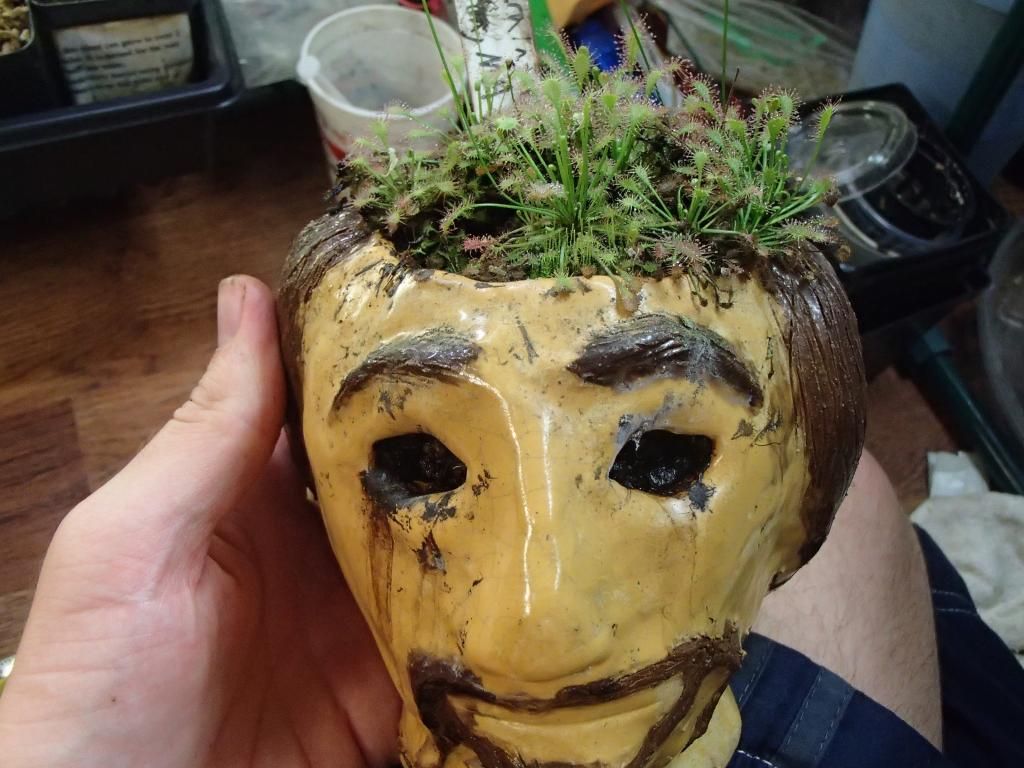
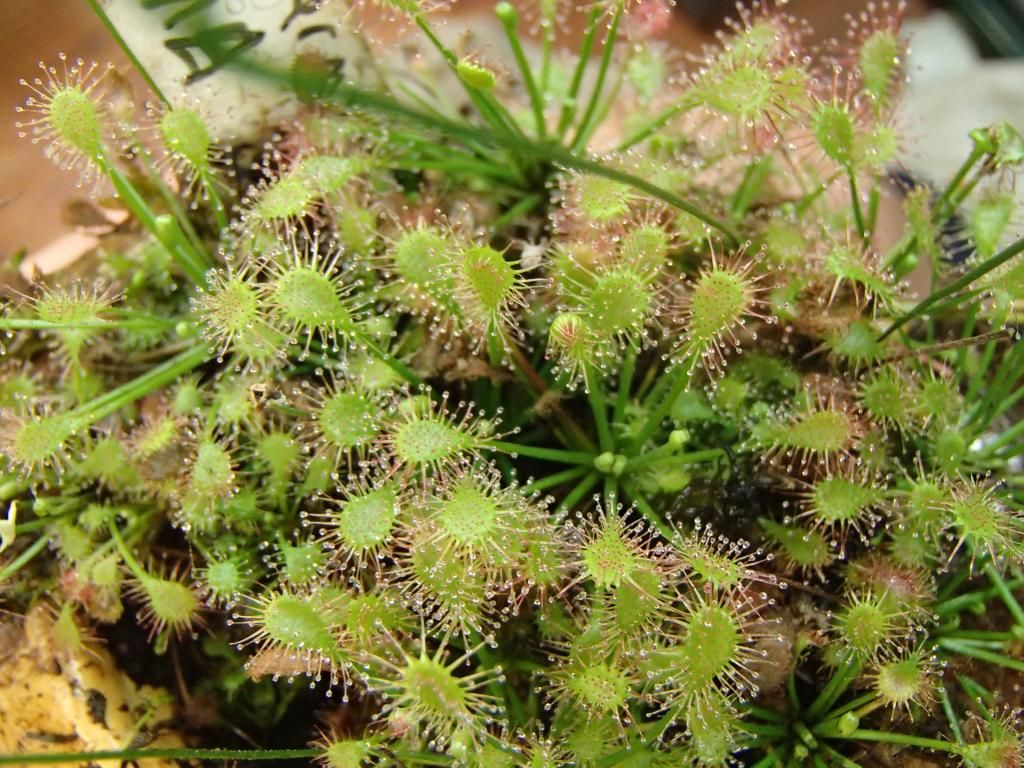
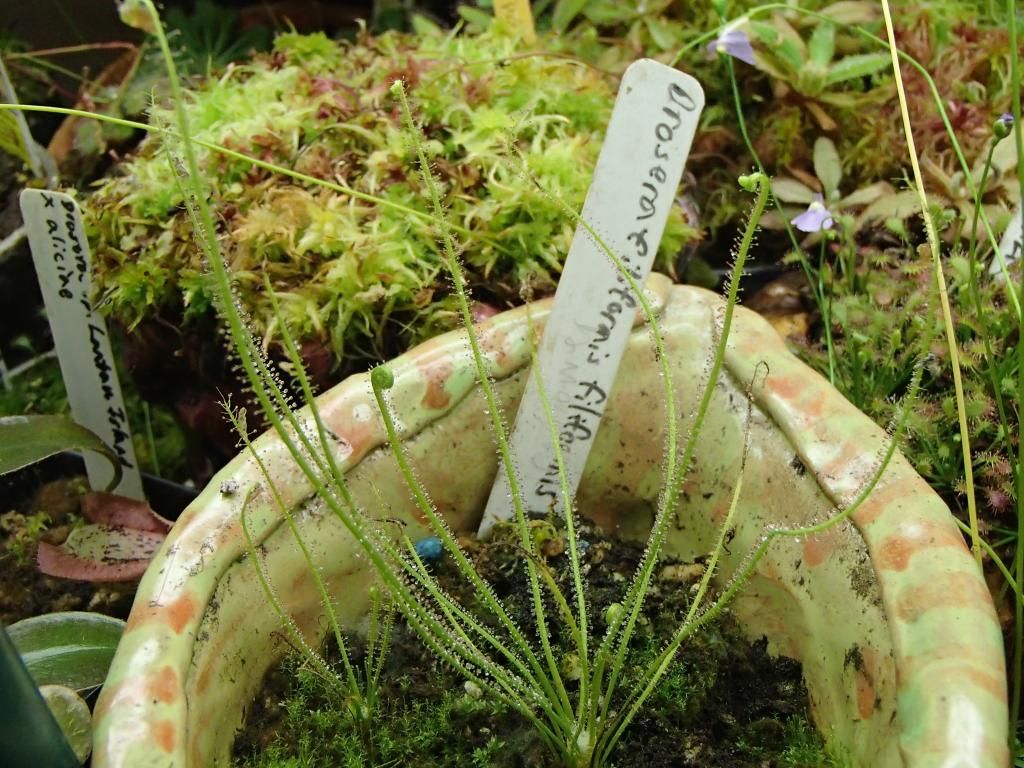
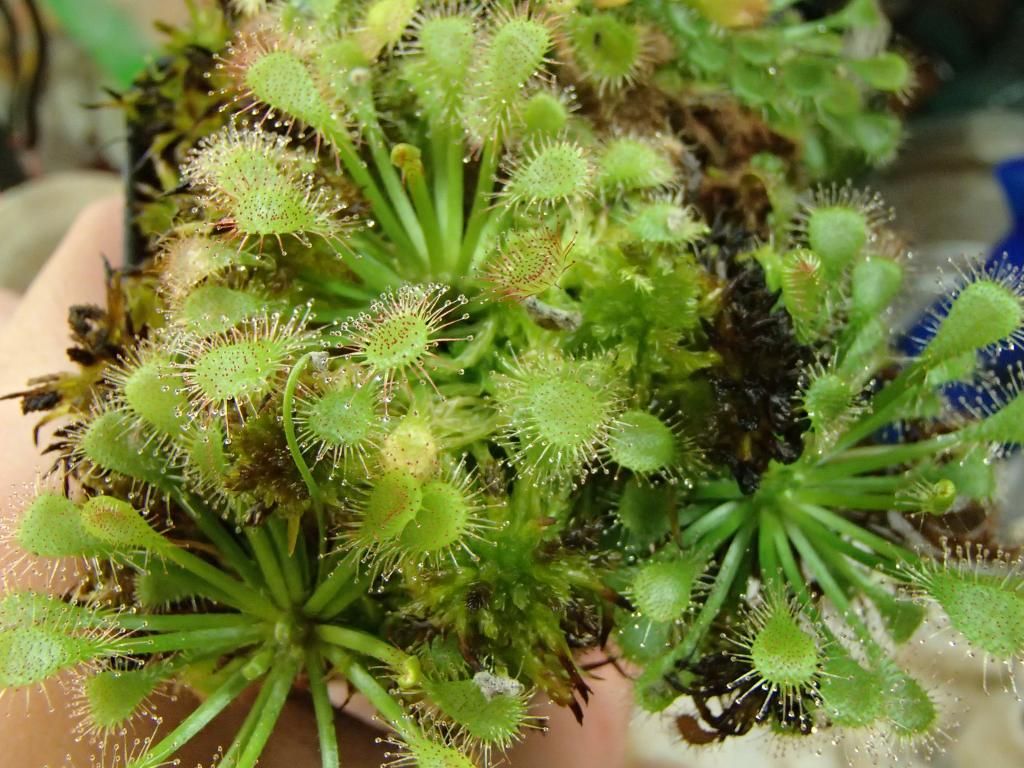
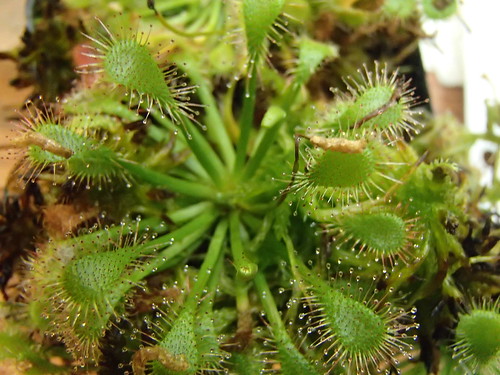
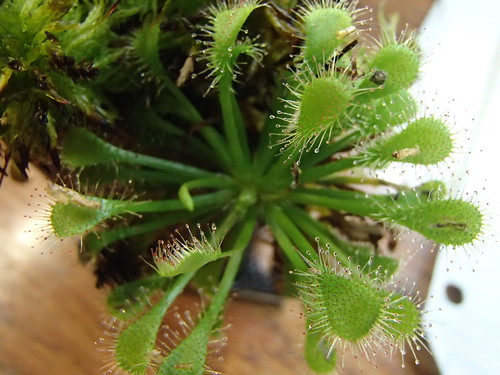
 )
)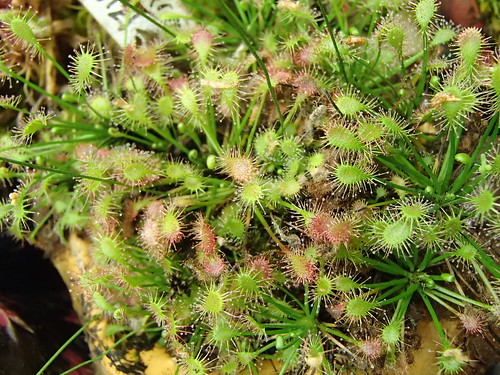
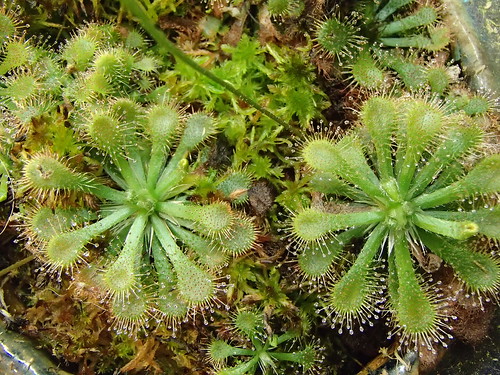
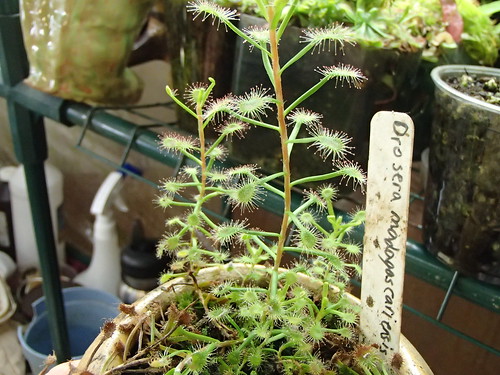
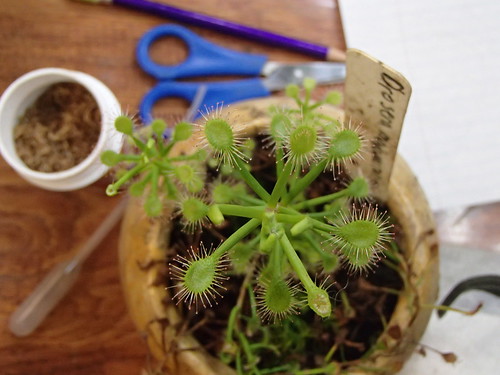
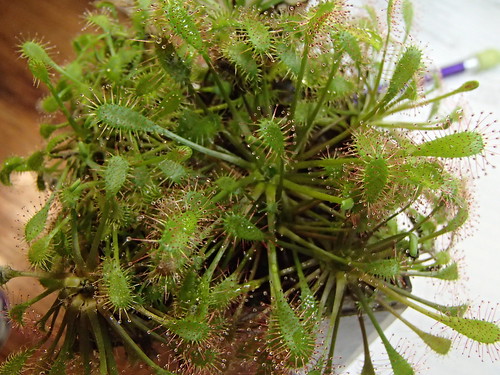
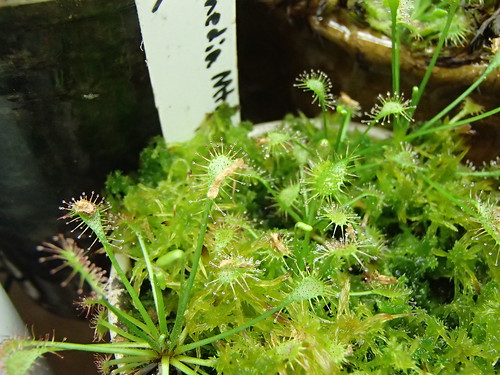
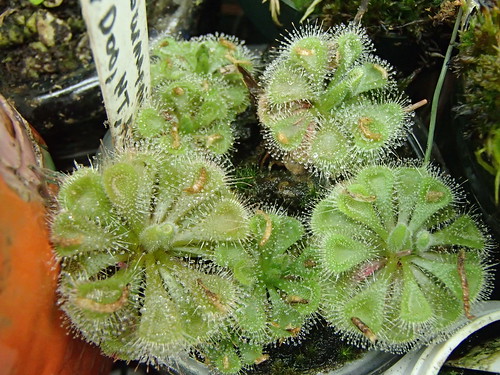
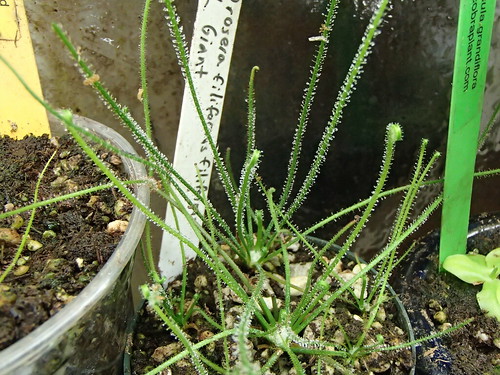


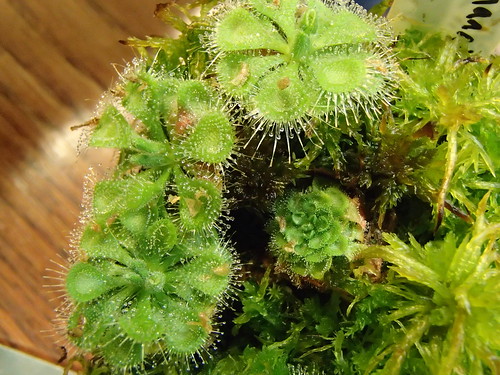
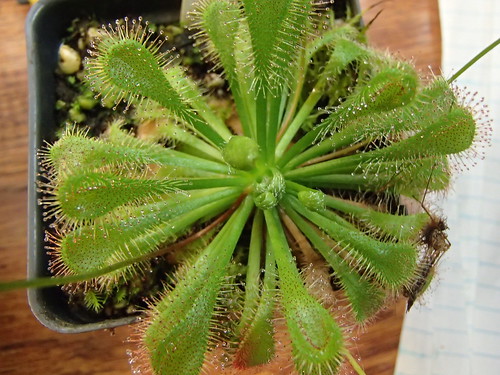
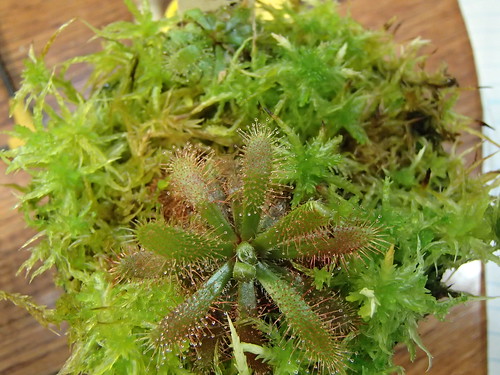
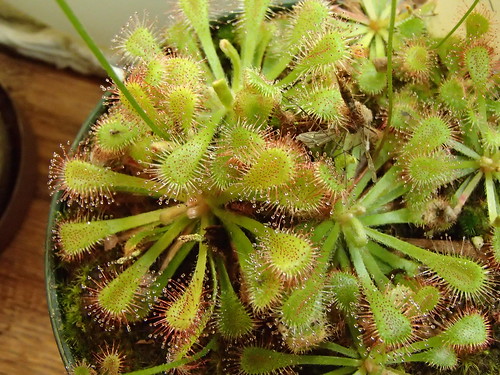
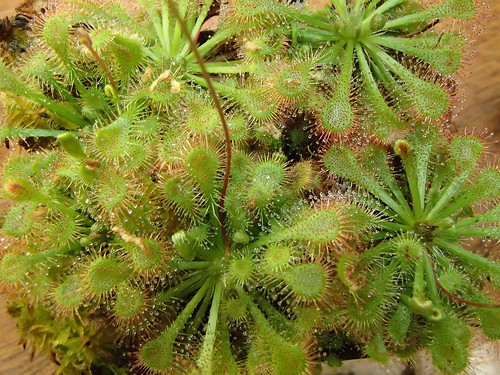
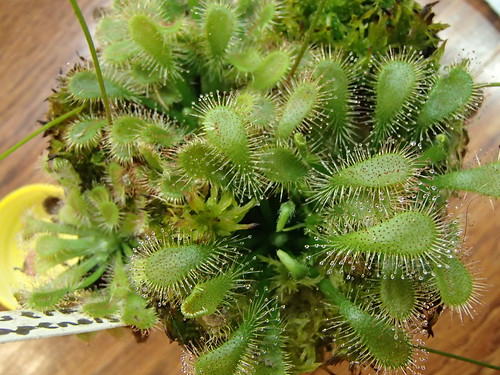
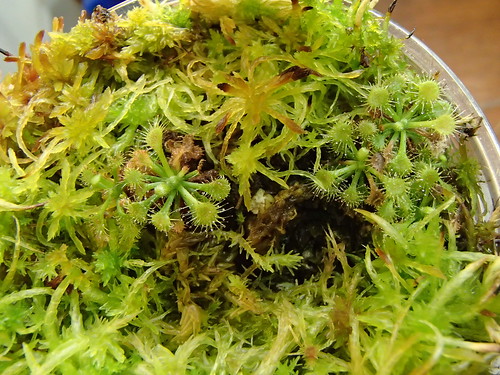
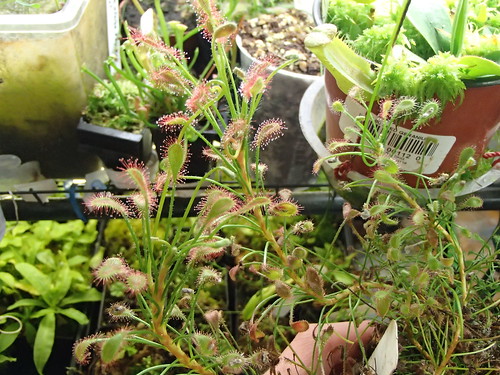
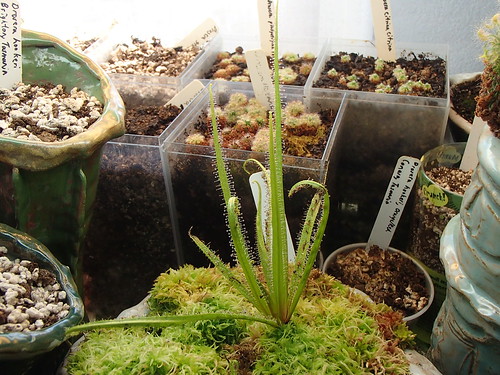

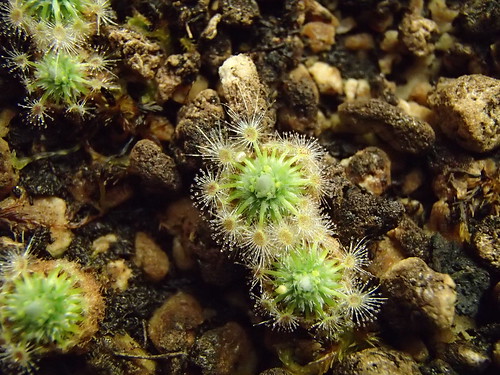
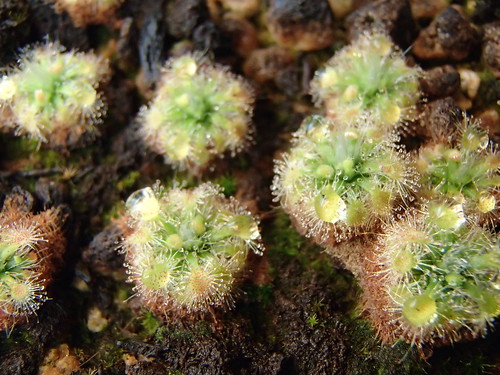
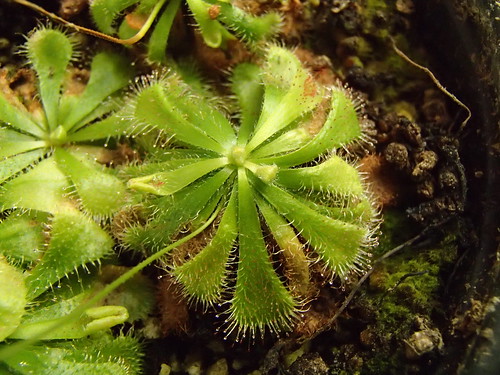

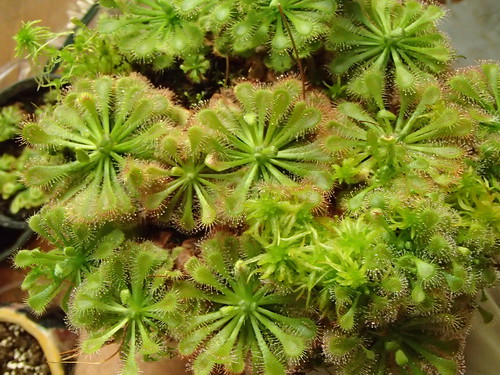
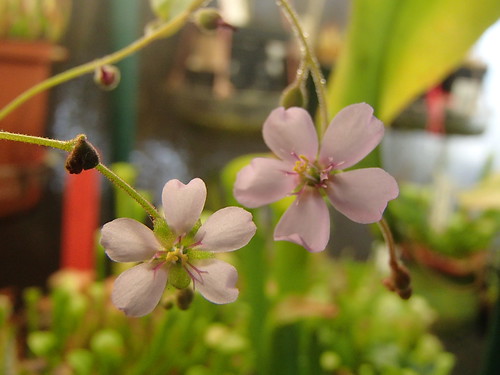


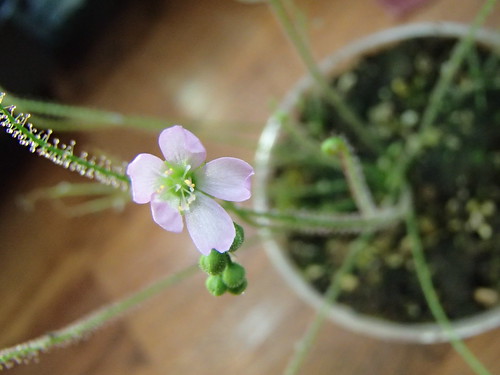
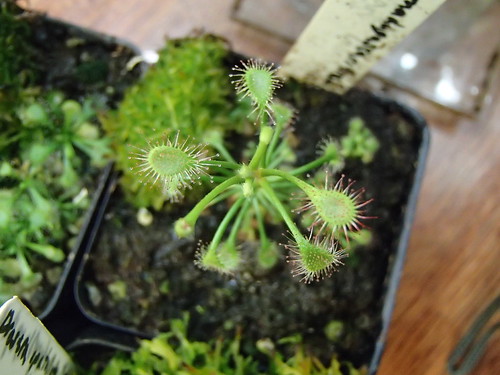
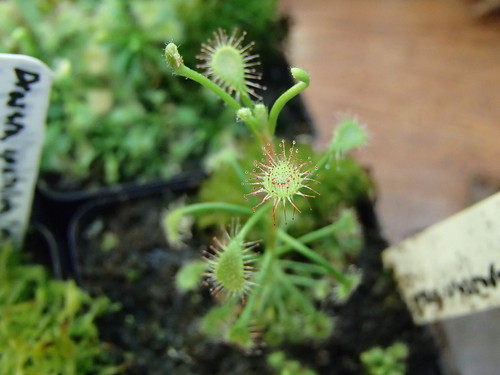

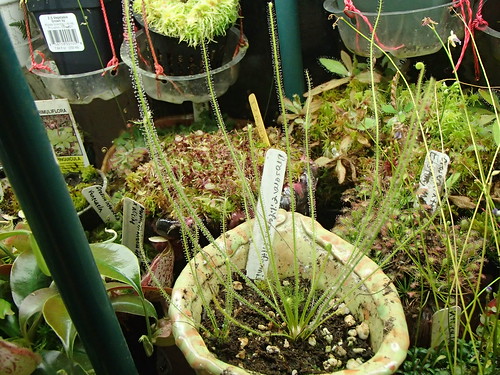
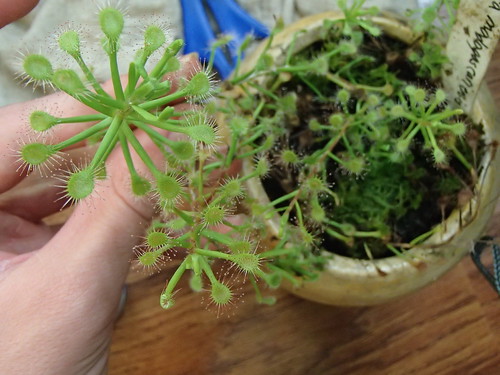
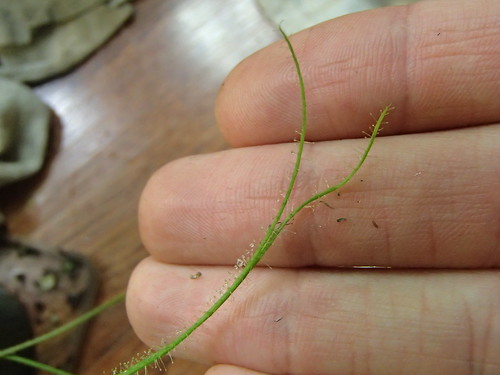
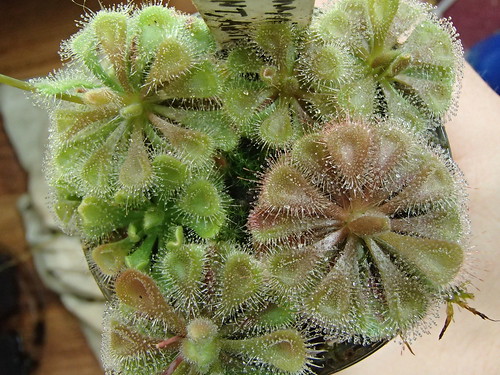
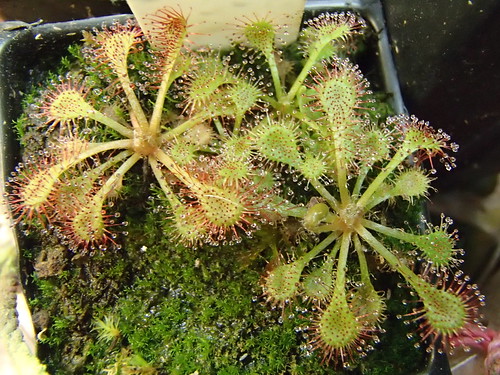
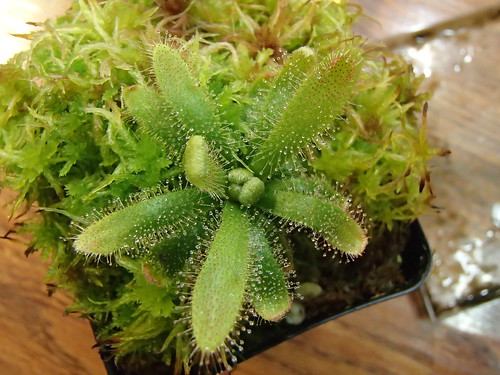

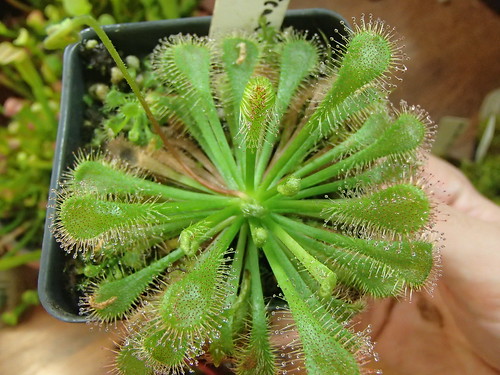

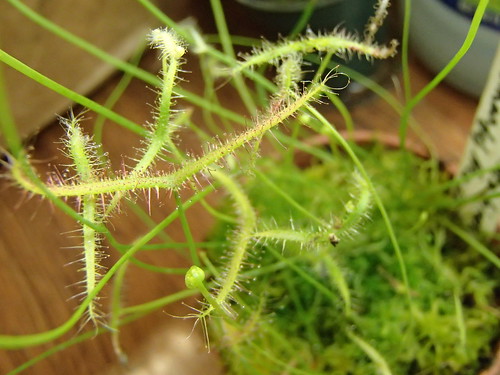

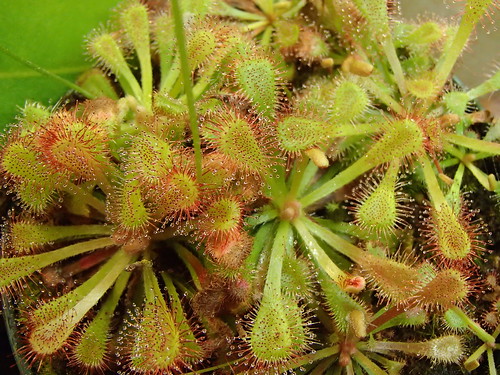

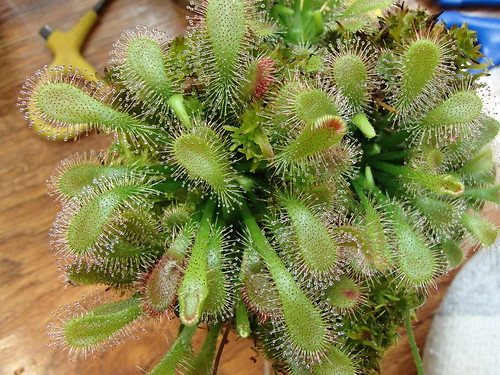
 Kidding, kidding
Kidding, kidding